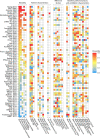Between-trial heterogeneity in ARDS research
- PMID: 33713156
- PMCID: PMC7955690
- DOI: 10.1007/s00134-021-06370-w
Between-trial heterogeneity in ARDS research
Abstract
Purpose: Most randomized controlled trials (RCTs) in patients with acute respiratory distress syndrome (ARDS) revealed indeterminate or conflicting study results. We aimed to systematically evaluate between-trial heterogeneity in reporting standards and trial outcome.
Methods: A systematic review of RCTs published between 2000 and 2019 was performed including adult ARDS patients receiving lung-protective ventilation. A random-effects meta-regression model was applied to quantify heterogeneity (non-random variability) and to evaluate trial and patient characteristics as sources of heterogeneity.
Results: In total, 67 RCTs were included. The 28-day control-group mortality rate ranged from 10 to 67% with large non-random heterogeneity (I2 = 88%, p < 0.0001). Reported baseline patient characteristics explained some of the outcome heterogeneity, but only six trials (9%) reported all four independently predictive variables (mean age, mean lung injury score, mean plateau pressure and mean arterial pH). The 28-day control group mortality adjusted for patient characteristics (i.e. the residual heterogeneity) ranged from 18 to 45%. Trials with significant benefit in the primary outcome reported a higher control group mortality than trials with an indeterminate outcome or harm (mean 28-day control group mortality: 44% vs. 28%; p = 0.001).
Conclusion: Among ARDS RCTs in the lung-protective ventilation era, there was large variability in the description of baseline characteristics and significant unexplainable heterogeneity in 28-day control group mortality. These findings signify problems with the generalizability of ARDS research and underline the urgent need for standardized reporting of trial and baseline characteristics.
Keywords: ARDS; Critical Care Research; Heterogeneity.
Conflict of interest statement
The authors declare that there is no conflict of interest.
Figures



Similar articles
-
Driving Pressure-limited Strategy for Patients with Acute Respiratory Distress Syndrome. A Pilot Randomized Clinical Trial.Ann Am Thorac Soc. 2020 May;17(5):596-604. doi: 10.1513/AnnalsATS.201907-506OC. Ann Am Thorac Soc. 2020. PMID: 32069068 Clinical Trial.
-
Meta-analysis: ventilation strategies and outcomes of the acute respiratory distress syndrome and acute lung injury.Ann Intern Med. 2009 Oct 20;151(8):566-76. doi: 10.7326/0003-4819-151-8-200910200-00011. Ann Intern Med. 2009. PMID: 19841457
-
The Impact of Sample Size Misestimations on the Interpretation of ARDS Trials: Systematic Review and Meta-analysis.Chest. 2022 Nov;162(5):1048-1062. doi: 10.1016/j.chest.2022.05.018. Epub 2022 May 26. Chest. 2022. PMID: 35643115
-
[Effects of mechanical ventilation with different tidal volumes on right ventricular hemodynamics in acute respiratory distress syndrome rats].Zhonghua Wei Zhong Bing Ji Jiu Yi Xue. 2021 Jan;33(1):49-52. doi: 10.3760/cma.j.cn121430-20200710-00513. Zhonghua Wei Zhong Bing Ji Jiu Yi Xue. 2021. PMID: 33565400 Chinese.
-
Standardized Management for Hypoxemic Respiratory Failure and ARDS: Systematic Review and Meta-analysis.Chest. 2020 Dec;158(6):2358-2369. doi: 10.1016/j.chest.2020.05.611. Epub 2020 Jul 3. Chest. 2020. PMID: 32629038
Cited by
-
Development and validation of a clinical risk model to predict the hospital mortality in ventilated patients with acute respiratory distress syndrome: a population-based study.BMC Pulm Med. 2022 Jul 11;22(1):268. doi: 10.1186/s12890-022-02057-0. BMC Pulm Med. 2022. PMID: 35820835 Free PMC article. Clinical Trial.
-
Mapping knowledge structure and emerging trends of extracorporeal membrane oxygenation for acute respiratory distress syndrome: a bibliometric and visualized study.Front Med (Lausanne). 2024 Jul 17;11:1365864. doi: 10.3389/fmed.2024.1365864. eCollection 2024. Front Med (Lausanne). 2024. PMID: 39086955 Free PMC article.
-
Unsuccessful and Successful Clinical Trials in Acute Respiratory Distress Syndrome: Addressing Physiology-Based Gaps.Front Physiol. 2021 Nov 30;12:774025. doi: 10.3389/fphys.2021.774025. eCollection 2021. Front Physiol. 2021. PMID: 34916959 Free PMC article. Review.
-
I-SPY COVID adaptive platform trial for COVID-19 acute respiratory failure: rationale, design and operations.BMJ Open. 2022 Jun 6;12(6):e060664. doi: 10.1136/bmjopen-2021-060664. BMJ Open. 2022. PMID: 35667714 Free PMC article.
-
Respiratory Subsets in Patients with Moderate to Severe Acute Respiratory Distress Syndrome for Early Prediction of Death.J Clin Med. 2022 Sep 27;11(19):5724. doi: 10.3390/jcm11195724. J Clin Med. 2022. PMID: 36233592 Free PMC article. Review.
References
-
- Bellani G, Laffey JG, Pham T, Fan E, Brochard L, Esteban A, et al. Epidemiology, patterns of care, and mortality for patients with acute respiratory distress syndrome in intensive care units in 50 Countries. JAMA. 2016;315(8):788–800. - PubMed
-
- Rubenfeld GD, Caldwell E, Peabody E, Weaver J, Martin DP, Neff M, et al. Incidence and outcomes of acute lung injury. N Engl J Med. 2005;353(16):1685–1693. - PubMed
-
- Villar J, Blanco J, Añón JM, Santos-Bouza A, Blanch L, Ambrós A, et al. The ALIEN study: incidence and outcome of acute respiratory distress syndrome in the era of lung protective ventilation. Intensive Care Med. 2011;37(12):1932–1941. - PubMed
-
- Fan E, Del Sorbo L, Goligher EC, Hodgson CL, Munshi L, Walkey AJ, et al. An Official American Thoracic Society/European Society of Intensive Care Medicine/Society Of Critical Care Medicine clinical practice guideline: mechanical ventilation in adult patients with acute respiratory distress syndrome. Am J Respir Crit Care Med. 2017;195(9):1253–1263. - PubMed
Publication types
MeSH terms
LinkOut - more resources
Full Text Sources
Other Literature Sources

